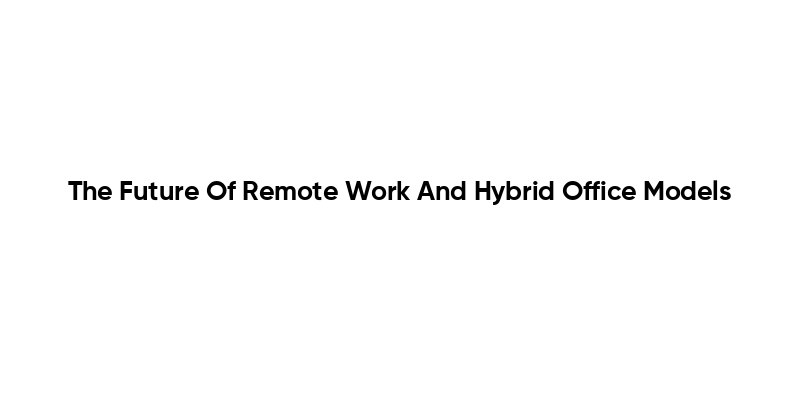The future of remote work and hybrid office models is rapidly evolving, driven by technological advancements and changing employee expectations. As organizations adapt to a more flexible work environment, understanding the dynamics of remote work and hybrid setups becomes essential. This article delves into the key trends shaping the future of work, including the rise of digital collaboration tools, the importance of work-life balance, and the impact of these models on productivity and employee satisfaction.
In the following sections, we will explore the benefits and challenges associated with remote work and hybrid office models. You will learn how companies are leveraging technology to create seamless communication channels, fostering a culture of inclusivity, and enhancing employee engagement. Additionally, we will discuss the role of leadership in navigating this transition and the strategies that can be implemented to ensure a successful hybrid work environment.
As we move forward, it is crucial to recognize that the future of work is not just about where we work, but how we work. By embracing flexibility and innovation, organizations can create a thriving workplace that meets the needs of both employees and employers. Join us as we uncover the transformative potential of remote work and hybrid office models, and discover how you can adapt to these changes for a more productive and fulfilling work experience.
The Evolution of Remote Work
The concept of remote work has evolved significantly over the past decade, driven by advancements in technology and changing workforce expectations. Initially, remote work was seen as a privilege for a select few, but the COVID-19 pandemic accelerated its adoption across various industries. Companies quickly adapted to remote work setups, utilizing tools like video conferencing, project management software, and cloud storage to maintain productivity. This shift has led to a reevaluation of traditional office spaces and the role they play in employee engagement and collaboration.
As organizations continue to embrace remote work, they are also recognizing the importance of flexibility. Employees now seek work environments that cater to their individual needs, whether that means working from home, a co-working space, or a hybrid model that combines both. This evolution is not just about where work is done, but also how it is done, with a focus on results rather than hours spent in the office.
Benefits of Hybrid Work Models
Hybrid work models offer a unique blend of remote and in-office work, providing employees with the flexibility to choose their work environment. This approach has been shown to enhance job satisfaction, as employees can tailor their work settings to their personal preferences. For instance, some may prefer the quiet of their home for focused tasks, while others thrive in the collaborative atmosphere of an office.
Moreover, hybrid models can lead to increased productivity. By allowing employees to work in environments that suit their tasks, organizations can harness the strengths of both remote and in-office work. Additionally, hybrid models can help companies reduce overhead costs associated with maintaining large office spaces, as they can optimize their real estate needs based on employee attendance patterns.
Challenges of Remote and Hybrid Work
While remote and hybrid work models present numerous advantages, they also come with their own set of challenges. One significant issue is the potential for communication breakdowns. In a remote setting, employees may feel isolated, leading to misunderstandings and a lack of cohesion within teams. Organizations must implement effective communication strategies to ensure that all team members remain connected and informed.
Another challenge is managing performance and accountability. With employees working in various locations, it can be difficult for managers to monitor productivity and ensure that goals are being met. Companies need to establish clear expectations and utilize performance metrics that focus on outcomes rather than hours worked, fostering a culture of trust and accountability.
Technology’s Role in Shaping the Future
Technology plays a crucial role in the success of remote and hybrid work models. The rise of collaboration tools, such as Slack, Microsoft Teams, and Zoom, has transformed how teams communicate and collaborate. These platforms enable real-time interaction, file sharing, and project management, making it easier for remote teams to work together effectively.
Furthermore, advancements in artificial intelligence and automation are set to enhance remote work experiences. AI-driven tools can help streamline workflows, manage schedules, and even provide insights into employee engagement. As technology continues to evolve, it will be essential for organizations to stay updated on the latest tools and trends to maintain a competitive edge in the remote work landscape.
The Future Workforce: Trends to Watch
As we look to the future, several trends are emerging that will shape the landscape of remote and hybrid work. One notable trend is the increasing emphasis on employee well-being. Organizations are recognizing the importance of mental health and work-life balance, leading to initiatives that support employee wellness, such as flexible hours and mental health resources.
Additionally, the gig economy is expected to grow, with more professionals opting for freelance or contract work. This shift will require companies to adapt their hiring practices and consider how to integrate gig workers into their teams effectively. As the workforce continues to evolve, organizations must remain agile and responsive to these changes to attract and retain top talent.
| Aspect | Description |
|---|---|
| Definition | Remote work refers to a work arrangement where employees do not commute to a central place of work. Hybrid models combine remote work with in-office attendance. |
| Trends | Increased adoption of technology, flexible work hours, and a focus on work-life balance are key trends shaping the future of work. |
| Benefits | Remote work offers flexibility, reduced commuting time, and access to a broader talent pool. Hybrid models provide a balance of collaboration and autonomy. |
| Challenges | Isolation, communication barriers, and difficulties in team cohesion are common challenges faced in remote and hybrid work environments. |
| Technology | Tools like video conferencing, project management software, and collaboration platforms are essential for effective remote and hybrid work. |
| Future Outlook | Organizations are likely to continue embracing flexible work arrangements, focusing on employee well-being and productivity while adapting to changing needs. |
| Best Practices | Establish clear communication channels, set expectations, and foster a culture of trust and accountability to enhance remote and hybrid work experiences. |



